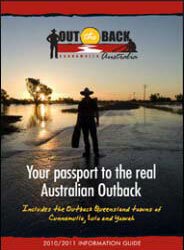
Bowra Station
- Details
- Category: Template articles
- Published Date
- Written by JBensusan
- Hits: 592
History
The McLaren Family, who originated from Scotland, settled Bowra Station (located on the outskirts of Cunnamulla) in the early 1900’s. Bowra was home to five generations of McLarens, with Ian and Julie McLaren as the last of the family to manage the property as a working sheep and cattle station.
In addition to sheep and cattle, Ian and Julie developed Bowra to host bird watchers. The couple’s intimate understanding of the ecology on Bowra and their vast knowledge of the varieties, and habitats of the rare birds that bred on Bowra, quickly attracted bird enthusiasts. This, along with the welcoming and laid back nature of the McLarens, soon had Bowra being touted as one of the leading specialist bird watching locations in Australia and possibly the world.
The original property was much larger than the Bowra of today, previously incorporating the Warrego River as its eastern boundary. Some of the property was resumed as a travelling stock route, while more of the land was donated to Cunnamulla District for the purpose of creating a local Golf Club. The Golf Club is still in operation today. In fact the original Bowra Homestead stands proudly alongside the new Club House.
During World War II, another part of Bowra was resumed by the Government to create an airfield, following the Japanese bombing of Darwin. Bowra was chosen as the site for this airfield, because Cunnamulla lies approximately halfway between Melbourne and Darwin, and the native vegetation (particularly the tree cover) on the property provided camouflage for the planes. The airfield was constructed by American forces, who carted water from the Artesian bore at Bowra to the airfield 24 hours a day. This same airfield serves as the current Cunnamulla Airport, which adjoins the Bowra property on three sides. Today, Bowra covers some 14,734 hectares (36,406 acres).
In 2010, Ian and Julie McLaren sold Bowra to the Australian Wildlife Conservancy and have retired on their magnificent Warrego River block, where they have amazing gardens to keep them young and healthy.
Bowra Sustainable Farming
Environmentally sustainable land practices had long been a part of the McLaren’s management of Bowra. This philosophy has been carried on through the generations and the family’s land strategies have continued to evolve over time. During the last major drought of the McLaren’s ownership and management of Bowra, these sustainable farming practices supported 500 cattle and 1000 sheep without any timber being sacrificed and only supplementary lick blocks being provided for stock.
Bowra Topography and Habitats
Bowra’s variable topography and its associated soil types give rise to a range of flora and fauna typical of and unique to South West Queensland. The careful management of land has maintained the presence and diversity of flora and fauna that occur naturally on Bowra.
Bowra Birdlife
To date, over 200 native species of birds have been recorded on Bowra (no introduced bird species have been recorded on the property), representing over a quarter of all bird species regularly recorded in Australia. These include 19 of the 25 Australian species of diurnal birds of prey, many of which have been recorded breeding on Bowra including Grey Falcon, Black Falcon, Black-breasted Buzzard and Square-Tailed Kite. Parrots are also well represented on Bowra with 13 species, all of which regularly breed on the property, including Bourke’s Parrot and Pink Cockatoo.
Bowra Mammals
Whilst the mammal fauna of Bowra is not as well documented as the birds, native mammals found on the property include five species of large macropod, namely; Red, Eastern Grey and Western Grey Kangaroos; Common Wallaroo and Swamp Wallaby; Short-Beaked Echidna; Kultarr, Fat-Tailed and Stripe-Faced Dunnarts and Water Rat. Roosting sites for several microbat species are also known on the property.
Bowra Reptiles
The diversity of Bowra’s land types and associated habitats has resulted in an impressive range of reptile species. These include: Snake-Necked and Broad-Shelled Turtle, Sand and Black-Headed Goanna, Central Bearded and other dragon species, several geckoes, numerous species of skink, legless lizards, blind snakes, Carpet Python and several species of Elapids, including Australian Coral Snake, De Vis’ Banded Snake, Red-Naped Snake, Mulga Snake, Western, Eastern and Ringed Brown Snakes, Myall Snake and Bandy-Bandy.
 Bowra Amphibians
Bowra Amphibians
With the many permanent and semi-permanent waterholes along the two creek systems that run through the property and the bore-fed artificial wetland near the homestead, amphibians are common on Bowra. These frogs include regularly encountered species, such as Desert, Green and Peron’s Tree Frogs and species found seasonally or following periods of heavy rainfall, such as the Crucifix Toad. During summer, the bore-fed wetland becomes an almost deafening cacophony of frog calls; however, even during winter it is not uncommon to hear at least five species calling at a single water body following rain.
Bowra Flora
The flora of Bowra is as equally impressive as the fauna. The environmentally sustainable land practices adopted by the McLaren family over the generations have ensured that the variety of plant life on the property has been maintained and the invasion of so-called woody weeds and exotic plants minimized. This is particularly evident by the abundance of native grasses that grow on Bowra, and in stony Mulga country. Following good winter rain, the wild grasses are transformed during Spring into an explosion of colour of ephemeral wildflowers. While a comprehensive list of flora occurring on Bowra has yet to be compiled, of the 54 native plant families recorded for arid and semi-arid Queensland by the Department of Primary Industries, over half of these are known to be present on Bowra.
Download Our Outback Travel Guide!
Testimonials
Weather
Guide & Maps
- Tourguide
- Map
- About us




